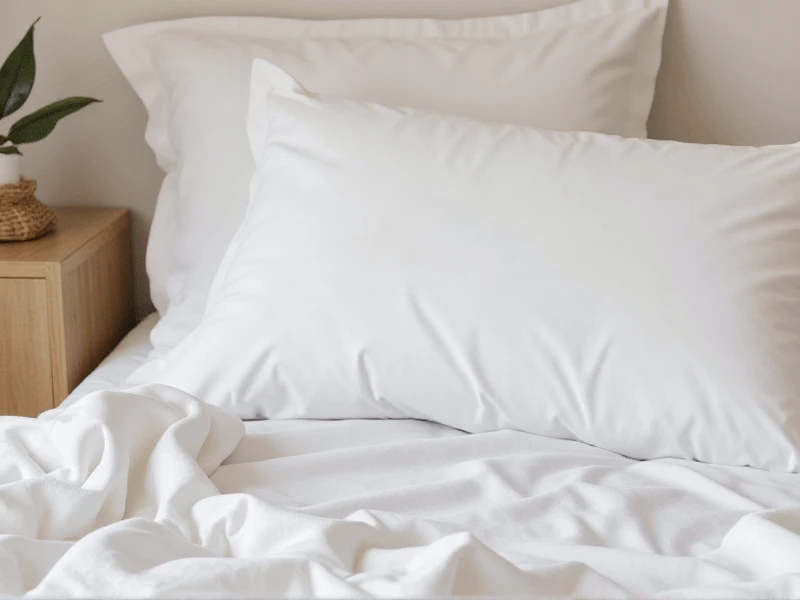Unlock Better Sleep: The Secret Lies in Your Pillowcases
2025-06-07

You spend roughly one-third of your life asleep. While much attention goes to mattresses and pillows, your pillowcases silently play a crucial, often underestimated role in sleep quality, skin health, and even hair vitality. Choosing the right ones isn't just about aesthetics; it's an investment in your nightly well-being.
Why Your Pillowcase Choice Matters
Think of your pillowcase as the final barrier between you and your pillow filling night after night. It directly impacts:
1. Temperature Regulation: Sleep comfort heavily depends on staying cool. Materials like cotton percale or bamboo viscose offer breathability, wicking moisture away, while traditional polyester might trap heat, leading to night sweats.
2. Skin Health: Rough fabrics can create friction against delicate facial skin overnight. This micro-abrasion can contribute to wrinkles and exacerbate conditions like acne (absorbing oils and bacteria). Conversely, smooth silk pillowcases, renowned for their glide, minimize pulling and tugging, potentially slowing wrinkle formation and being gentler on acne-prone skin.
3. Hair Care: Friction is also the enemy of healthy hair. Cotton pillowcases can cause tangles, knots, and frizz, especially for curly or textured hair types. Silk and satin alternatives drastically reduce this friction, helping prevent breakage, split ends, and morning "bedhead," as well as maintaining hairstyles longer. They also help lock in hair moisture naturally.
4. Allergy Prevention: For those sensitive to dust mites or allergens, hypoallergenic pillowcases, often tightly woven organic cotton or bamboo, create a barrier. Regular washing is vital, regardless of material.
5. Durability & Feel: The material dictates longevity and the sensory experience against your skin nightly, significantly influencing overall sleep satisfaction.
Popular Pillowcase Material Showdown
Cotton: The classic choice. Comes in various weaves:
Percale: Crisp, cool, and matte – excellent breathability.
Sateen: Soft, smooth with a subtle sheen – feels luxurious but less breathable than percale.
Flannel: Warm, cozy, brushed surface – ideal for colder months.
Pros: Natural, breathable (especially percale), durable, generally affordable. Highly absorbent.
Cons: Can wrinkle easily. Standard cotton might pill over time. Can cause skin/hair friction.
Linen: Grown from flax plants. Prized for its breathability and moisture-wicking abilities, keeping you cool in summer and warm in winter. Naturally gets softer with each wash. Has a distinctive, relaxed texture.
Pros: Highly durable, thermoregulating, eco-friendly, unique aesthetic.
Cons: More expensive, wrinkles significantly (considered part of its charm), stiffer feel initially.
Silk (Mulberry Silk is Best): Often called "the beauty secret." A luxurious natural protein fiber creating an incredibly smooth, low-friction surface.
Pros: Gentle on skin & hair, minimizes friction-related wrinkles/messy hair, naturally hypoallergenic (resists dust mites).
Cons: Requires delicate care (usually hand wash/hand dry), expensive, offers less warmth.
Bamboo Viscose/Rayon: Made from bamboo pulp. Known for exceptional softness, often compared to silk. Naturally temperature-regulating and moisture-wicking.
Pros: Very soft & silky feel, eco-friendly (if sustainably sourced), breathable, hypoallergenic. Often more affordable than silk.
Cons: Can sometimes retain odors if not washed properly, requires careful washing to prevent pilling or shrinking. Confirm if chemically processed.
Synthetic Blends (Polyester, Microfiber): Offer affordability and wrinkle/shrink resistance but generally lack breathability.
Pros: Inexpensive, easy care, durable, resist wrinkles.
Cons: Trap heat, can cause sweating, prone to static, potentially irritate sensitive skin, feel less luxurious.
Finding Your Perfect Pillowcase Match
Consider these factors:
Primary Need: Cooling? Silk/Satin for skin/hair? Hypoallergenic? Budget?
Feel: Crisp (percale)? Silk-like (bamboo)? Soft and warm (sateen/flannel)?
Budget: Silk pillowcases are premium. Cotton percale or high-quality bamboo offer excellent value. Linen is durable but upfront cost is higher.
Care: Do you prefer machine wash/dry? Silk needs extra care.
Care Tips for Long-Lasting Pillowcases
Regardless of material, proper care maximizes lifespan:
Wash Weekly: Essential for hygiene and preventing oil/skin cell buildup, especially crucial with acne-prone skin or allergies.
Follow Care Labels: Temperature and drying instructions vary greatly. Gentle cycles and mild detergent protect fibers. Avoid harsh chemicals/brighteners.
Don't Overcrowd: Ensure ample space in the washer/dryer for proper cleaning and drying.
Beyond the Basics: Features to Consider
Envelope Closure vs. Zipper: Envelope style keeps pillows securely tucked without zipper discomfort; zipper offers ultimate security. Shams add decorative coverings but need frequent washing too.
Hypoallergenic Certification: Crucial for allergy sufferers.
Sustainable Materials (Organic Cotton, Linen, TENCEL Lyocell Bamboo): Better for the planet.
Cooling Technologies: Some incorporate specialized weaves or treatments.
Upgrading your pillowcases is one of the simplest yet most effective ways to enhance your sleep sanctuary and care for your skin and hair while you rest. Whether seeking the cooling kiss of percale, the gentle glide of silk, the soft luxury of bamboo, or the rustic charm of linen, the perfect pair promises to make every night feel a little better. Invest wisely in this nightly touchpoint!
Category: